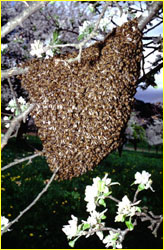Royal Jelly
Royal jelly is an emulsion of proteins, sugars and lipids in a water base, and is synthesised by the bee from pollen. 82-90% of the protein content is made up of a group of proteins found only in royal jelly and worker jelly, known as the Major Royal Jelly Proteins (MRJPs), which has five main members. These are rich in the essential amino acids (ie. those amino acids which cannot be biosynthesised), and so play an important role in bee nutrition. The MRJPs do not show any enzyme activity or other special properties, and so they do not seem to have any role other than nutrition.
Most of the components of royal jelly seem to be designed to provide a balance of nutrients for the larvae. However, the lipids present are unusual, in that they are unlike the lipids of typical insect fats, which consist of 14-20 carbon fatty acids. Royal jelly lipids are composed mainly of 8-10 carbon acids, hydroxy acids and diacids, which may be saturated, unsaturated, linear or branched. They include hexanoic acid, octanoic acid, (E)-oct-2-enoic acid, 8-hydroxyoctanoic acid, 3- and 10-hydroxydecanoic acid, and 3,10-dihydroxyoctanoic acid. 10-hydroxydecanoic acid levels rise dramatically in summer.
Royal jelly also contains 7-9 sterols, 4 phospholipids, 5 glycolipids, and a variety of 16-33 carbon hydrocarbons.
The unusual lipids of royal jelly make it highly acidic, and give it good antimicrobial properties. This seems to be the main role of the lipids. However, these properties disappear above pH 6, so while royal jelly may be used as an effective skin-care product, its antimicrobial properties are negligible within the body, where the pH is maintained at about 7.4 by buffering systems. Because of this, there does not seem to be any pharmaceutical use for royal jelly. However, its good balance of nutrients and high nutrient levels mean that it has become a highly touted specialised health food.

Bee eggs in the comb. Only eggs fed on royal jelly become queens.
As with propolis, royal jelly also appears to have anti-tumour properties. A team of researchers gave royal jelly to one of two groups of laboratory mice before transplanting cancer cells into them. The royal jelly was shown to have no effect on leukaemia cells, but it had dramatic effects on sarcoma cells. The lifespan of the mice fed on royal jelly was extended by about one-fifth and the tumours were found to be about half the size of those in the untreated mice.
Royal Jelly is a white, creamy substance, produced in the mandibular and hypopharyngeal glands of worker bees, and used in the ‘production’ of queen bees.
When the colony becomes crowded, royal jelly is fed to a dozen or so larvae which would normally develop into workers, which instead become queens. Shortly before these new virgin queens hatch, the old queen leaves the hive, taking with her a swarm of 5000 to 25000 worker bees. After a few minutes flight from the hive, the queen stops on a branch or other feature (which may even be a parked car), and the swarm settles in a tight ball around her. Scouts then search the surrounding area for a suitable place for the new hive. Swarming normally takes place in the middle of a warm day.
The picture on the right shows a typically-sized swarm on a branch.
